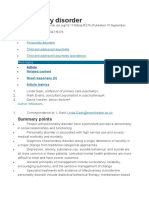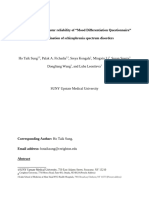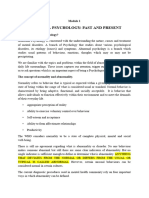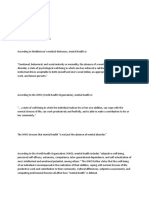Original Article Psychological Status And: Coping Strategy of Somatization Disorders
Original Article Psychological Status And: Coping Strategy of Somatization Disorders
Uploaded by
ityCopyright:
Available Formats
Original Article Psychological Status And: Coping Strategy of Somatization Disorders
Original Article Psychological Status And: Coping Strategy of Somatization Disorders
Uploaded by
ityOriginal Title
Copyright
Available Formats
Share this document
Did you find this document useful?
Is this content inappropriate?
Copyright:
Available Formats
Original Article Psychological Status And: Coping Strategy of Somatization Disorders
Original Article Psychological Status And: Coping Strategy of Somatization Disorders
Uploaded by
ityCopyright:
Available Formats
Int J Clin Exp Med 2016;9(9):18564-18568
www.ijcem.com /ISSN:1940-
5901/IJCEM0026387
Original Article Psychological status and
coping strategy of somatization disorders
Haijie Zhang, Zhihua Zhang, Danning
Zhang
Shandong Mental Health Center, Jinan, P. R.
China
Received February 22, 2016; Accepted June 4, 2016; Epub September 15, 2016; Published September 30,
2016
Abstract: Objective: To evaluate the psychological status of patients with somatization disorders by using
question- naire survey and professional mental scale, aiming to provide effective coping strategies for
psychological and physical recovery. Methods: Fifty patients diagnosed with somatization disorder and 50
corresponding family mem- bers were assigned into the study group. Fifty healthy subjects and 50 their
family members were allocated into the control group. All participants received comprensive evaluation by
using SCL-90, SSRS and CSQ. Results: In the study group, the average scores of a majority of items in the
SAS and SDS were significantly higher than those in the control group (all P<0.05). The mean scores of
overall social and subjective support in patients with somatization disorder were considerably lower than
those in their counterparts (all P<0.05). In the study group, the average score of negative factor was
significantly higher whereas that of the positive factor was apparently lower compared with the values
obtained in the control group (all P<0.05). Conclusion: Patients diagnosed with somatization disorder and
their family members present with evident psychological symptoms, lack of social support and effective strat-
egy against the symptoms of somatization disorder.
Keywords: Somatization disorder, psychological health,
strategy
Introductio novel devel- opments and advancements
n have been accom- plished in terms of
somatization disorder, which is among the
Somatization disorder, also known as most challenging of psychiatric disorders
Briquet’s syndrome, is defined as a mental encountered in clinical experiences. Multiple
disorder clini- cally characterized by diagnostic criteria have been revised to
recurring, multiple and clinically significant facilitate the clinical diagnosis and corre-
complaints about somatic symptoms [1-3]. It sponding strategy. At present, differential
has been recognized in the DSM-IV-TR diag- nostic tools mainly include neurologic
classification scale, which is com- bined with disor- ders, systemic medical disorders, and
undifferentiated somatoform disor- der to alter- native psychiatric disorders, such as
become somatic symptom disorder in the mental anxiety disorders, conversion
latest version DSM-5, in which the diagnos- disorder, malin- gering, and factitious
tic criteria does not require a specific disorder, etc. Previous
number of somatic symptoms [4-7]. Multiple studies have reported that a large proportion
of patients present with more than one of been reported to assess the discrepancy
such ill- nesses complicated with between the patients and their family
somatization disorder [8-11]. In clinical members in terms of mental and psycho-
practice, somatization disor- der requires logical issues. In this study, multiple
comprehensive and novel psycho- social evaluation scales have been utilized to
treatment designed by the professional assess the mental and psychological status,
neurologists and psychiatrists and explore the major problems and identify
alternative mental experts. effective interventional strategies to radically
resolve these issues from both social and
However, most previous investigations family perspectives, which probably elevate
mainly focus upon evaluating the mental the mental recovery and qual- ity of life of
status of patients diagnosed with patients suffering from somatiza- tion
somatization disorder. Few studies have disorder.
Psychological status and coping strategy of somatization disorders
Materials and methods
Study subjects
In total, 50 patients diagnosed with somatiza- tion disorder admitted to XXX hospital between September
2014 and October 2015 and their family members (n=50) were recruited into the study group. All patients
were diagnosed acc- ording to International Statistical Classification of Diseases and Related Health
Problems [xxx] (ICD-10).
Among 50 patients, there were 13 males and 37 females, aged from 16 to 73 years, with mean age 43.8
± 10.7 years. Twelve patients had educational level of elementary school or below, 25 with junior middle
school, 9 with spe- cialized middle school or senior high school and 4 with college or university
background or above. Adult family members who could under- stand the survey contents, normal mental
state, without severe physical or psychological diseases or systemic illnesses were eligible for
subsequent analysis. Seven pairs of partici- pants were spouses, 11 were mother-and-son relationship,
12 were mother-and-daughter relationship, 6 were father-and-daughter rela- tionship, 6 were father-and-
son relationship, 5 were brother or sister relationship and 3 were mother and daughter-in-law relationship.
In the control group, 50 normal controls were all staff from XXX hospital. Meantime, 50 family members of
these 50 control individuals were also enrolled in this study. Adult family mem- bers who were able to
comprehend the survey contents, with normal mental state, without severe physical or psychological
diseases or systemic illnesses were eligible for subsequent survey.
Among 50 healthy controls, there were 14 males and 36 females, aged from 16 to 71 years, with mean
age 41.4 ± 10.3 years. Nine had educational level of elementary school or below, 17 with junior middle
school, 19 with specialized middle school or senior high school and 5 with college or university
educational lev- els or above. Ten pairs of participants were spouses, 12 were mother-and-son
relationship, 10 were mother-and-daughter relationship, 5 were father-and-daughter relationship, 5 were
father-and-son relationship, 6 were brother or sister relationship and 2 were mother and daughter-in-law
relationship.
18565 Int J Clin Exp Med 2016;9(9):18564-18568 The gender, age, educational background and patient-
family member relationship were totally matched with no statistical significance bet- ween the study and
control groups (all P>0.05).
Survey questionnaire
Symptom checklist-90 scale: The Symptom Ch- ecklist-90-R (SCL-90-R) is a relatively brief psy-
chometric instrument self-reported by the patients. SCL-90 is specially designed for indi- viduals aged 13
years and older, which consists of 90 items and takes 12-15 minutes to accom- plish all questions,
generating 9 scores along primary symptom dimensions and 3 scores among global distress indices.
Primary symp- tom dimensions that are assessed include somatization, obsessive-compulsive, interper-
sonal sensitivity, depression, anxiety, hostility, phobic anxiety, paranoid ideation, psychoti- cism, and a
category of “additional items” whi- ch assists the physicians to thoroughly evalu- ate alternative
perspectives of the symptoms of enrolled patients.
Social support rating scale: Social support rat- ing scale (SSRS) is composed of 10 items which are
divided into objective support, subjective support and social support covering three dimensions in total.
The questionnaire consists of problems and difficulties based on psycho- logical stress of patients and
multiple choices according to the sources of social support.
Coping style questionnaire: Coping style ques- tionnaire (CSQ) includes 62 items which are classified into
6 subscales, such as problem resolving, self-complain, seeking help, fantasy, escape and rationalization.
The score scale ranges from 0 or 1 system. Trait coping style questionnaire (TCSQ) and simplified coping
style questionnaire (SCSQ) were adopted to assess the negative and positive coping stra- tegies.
Results
Comparisons of SCL-90 scores between the study and control groups
As illustrated in Table 1, the mean scores of 8 items in patients diagnosed with somatization disorder and
their family members were signifi- cantly higher than those values in the healthy counterparts (all P<0.05).
However, the mean score of hostility item did not significantly differ between two groups (P>0.05).
Psychological status and coping strategy of somatization disorders
Table 1. Comparison of SCL-90 scores between the study and control groups
Study group (n=50) Control group (n=50) P Patient Family member Healthy subject Family member Somatization
disorder 2.93 ± 0.71 1.74 ± 0.56 1.36 ± 0.67 1.37 ± 0.48 <0.05 Obsessive-compulsive 2.91 ± 0.89 1.97 ± 0.43 1.67 ±
0.56 1.68 ± 0.53 <0.05 Interpersonal sensitivity 2.21 ± 0.77 1.97 ± 0.68 1.68 ± 0.80 1.65 ± 0.62 <0.05 Anxiety 2.49 ±
0.60 2.28 ± 0.43 1.42 ± 0.56 1.35 ± 0.39 <0.05 Depression 2.80 ± 0.67 1.83 ± 0.62 1.49 ± 0.77 1.61 ± 0.64 <0.05
Hostility 2.16 ± 0.56 1.52 ± 0.44 1.98 ± 0.69 1.48 ± 0.48 >0.05 Phobia 1.70 ± 0.82 1.64 ± 0.56 1.27 ± 0.68 1.25 ± 0.51
<0.05 Paranoid ideation 2.62 ± 0.56 1.80 ± 0.55 1.43 ± 0.67 1.42 ± 0.63 <0.05 Psychoticism 1.89 ± 0.49 1.32 ± 0.50
1.28 ± 0.55 1.28 ± 0.46 <0.05
Table 2. Comparison of SSRS scores between the study
Discussion and control groups
Study group
Control (n=50)
P
group (n=50) Total score 34.60 ± 7.89 38.96 ± 7.21 <0.05 Objective support score 9.12 ± 4.83 7.63 ± 5.37 >0.05
The results in this study indicated that patients diagnosed with somatization disorder constantly suffer
from psy- chological problems. Patients with somatization disorder suffer from Subjective support score
18.73 ± 5.34 24.01 ± 6.27 <0.05
severe financial challenge to the Availability 9.25 ± 3.36 9.54 ± 3.35 >0.05
health service due to the fact that symptoms are often intractable and
Table 3. Comparison of CSQ scores between the study and control groups
require long-term care. During hospi- talization, the physicians and nurses place much attention to the
patients, Study group
Control group (n=50)
P
(n=50)
whereas neglect the education to- wards the family members of the Positive coping style score 24.34 ± 7.85
36.14 ± 8.04 <0.05
patients, which may negatively affects Negative coping style score 34.45 ± 5.7 24.86 ± 6.13 <0.05
the recovery of the quality of life of patients.
Comparisons of SSRS scores between the study and control groups
As revealed in Table 2, the total score and sub- jective support score in the study groups were
significantly lower compared with those values in the control group (both P<0.05). However, the objective
support score and the availability score did not considerably differ between the study and control groups
(both P>0.05).
Comparisons of CSQ scores between the study and control groups
As illustrated in Table 3, the mean score of pos- itive coping style in the study group was signifi- cantly
lower than that in the control group (P<0.05), whereas the average score of nega- tive coping style in the
study group was consid- erably higher than that in the control group (P<0.05).
18566 Int J Clin Exp Med 2016;9(9):18564-18568 Through administering questionnaire, the true
psychological status of patients was acknowl- edged by the medical staff under the prerequi- site of
eliminating the anxiety emotion and obtaining mutual trust between patients and physicians. If the patients
were unable to com- plete the survey independently, relevant nurses should provide certain assistance to
help them to accomplish the task.
Upon admission, the nurses were responsible for explaining the specialized knowledge regard- ing
somatization to the patients via multiple channels, such as online chat tool, Weibo blog and alternative
online platforms. Furthermore, the patients were informed about the diagno- sis, treatment strategy and
process. Such assistance could not only make the patients better understand somatization disorder, but
also increase their confidence in the treatment and recovery.
Psychological status and coping strategy of somatization disorders
Besides the patients themselves, their family
Address correspondence to: Danning Zhang, Shan- members are likely to suffer from emotional
dong Mental Health Center, 49 Wen Hua Dong Road, problems due to high medical cost and long-
Jinan 250014, P. R. China. E-mail: doczdn@126.com term taking care of the patients. These eco- nomic and
psychological burdens may nega-
References tively and extensively affect the occupation, study and daily life of the patients’ family mem-
bers, eventually leading to anxiety, stress and even depression [12, 13]. The nursing group should take
responsibility to deliver psychologi- cal assistance and guidance to the family mem-
[1] Keng SL, Smoski MJ, Robins CJ. Effects of mindfulness on psychological health: a review of empirical studies.
Clin Psychol Rev 2011; 31: 1041-1056. [2] Teasdale JD, Segal ZV, Williams JM, Ridgeway VA, Soulsby JM, Lau MA.
Prevention of relapse/ bers, help them to properly adjust mental sta-
recurrence in major depression by mindful- tus, reduce psychological burden, and actively
ness-based cognitive therapy. J Consult Clin and devotedly take care of the patients, which
Psychol 2000; 68: 615-623. can collectively accelerate the psychological recovery of the patients.
Establishing a channel of frequent and effective communication bet- ween patients, family members and
physicians significantly elevates the cognitive understand- ing of patients towards the disease, satisfy
their psychological needs and enhance their confidence upon the clinical treatment and fast
[3] Morley S, Eccleston C, Williams A. Systematic review and meta-analysis of randomized con- trolled trials of
cognitive behaviour therapy and behaviour therapy for chronic pain in adults, excluding headache. Pain 1999; 80: 1-
13. [4] Lipowski ZJ. Somatization: the concept and its clinical application. Am J Psychiatry 1988; 145: 1358-1368.
recovery.
[5] Kroenke K, Swindle R. Cognitive-behavioral
The support from family members of the
therapy for somatization and symptom syn- dromes: a critical review of controlled clinical patients takes great
responsibility [14]. First,
trials. Psychother Psychosom 2000; 69: 205- family member who take care of the patients
215. should learn to deliver psychological hints to
[6] Kaplan KH, Goldenberg DL, Galvin-Nadeau M. help the patients to correct their inappropriate behaviors,
which make the patients better understand themselves and enhance self-con- fidence and eliminate
negative feelings. The physicians and nurses should guide family members to attend the lectures
regarding somatization disorder, which widens their view- point and understanding of the pathogenesis,
The impact of a meditation-based stress re- duction program on fibromyalgia. Gen Hosp Psychiatry 1993; 15: 284-
289. [7] Fukuda K, Straus SE, Hickie I, Sharpe MC, Dob- bins JG, Komaroff A. The chronic fatigue syn- drome: a
comprehensive approach to its defi- nition and study. International Chronic Fatigue Syndrome Study Group. Ann
Intern Med 1994; 121: 953-959. diagnosis and treatment of somatization disor-
[8] Van Damme S, Crombez G, Van Houdenhove der. Besides, they can learn useful techniques
B, Mariman A, Michielsen W. Well-being in pa- in terms of physical movement, rest duration
tients with chronic fatigue syndrome: the role and recovery knowledge, etc.
of acceptance. J Psychosom Res 2006; 61: 595-599. Due to the complex pathogenesis and frequent
recurrence of somatization disorder, identifying the intrapsychic conflicts of the patients and implement
effective coping styles play a pivotal role in the success of corresponding therapy [15, 16]. Understanding
of the complex neuro- biological, psychological and social causes of somatization disorder contributes to
improve
[9] Spiller R, Aziz Q, Creed F, Emmanuel A, Hough- ton L, Hungin P, Jones R, Kumar D, Rubin G, Trudgill N,
Whorwell P; Clinical Services Com- mittee of The British Society of Gastroenterol- ogy. Guidelines on the irritable
bowel syn- drome: mechanisms and practical manage- ment. Gut 2007; 56: 1770-1798. [10] Naliboff BD, Frese MP,
Rapgay L. Mind/Body psychological treatments for irritable bowel diagnostic accuracy and therefore the capacity
syndrome. Evid Based Complement Alternat to develop a treatment plan tailored to the spe-
Med 2008; 5: 41-50. cial needs of each patient.
[11] Ljotsson B, Andreewitch S, Hedman E, Ruck C, Andersson G, Lindefors N. Exposure and mind- Disclosure of
conflict of interest
fulness based therapy for irritable bowel syn- drome-an open pilot study. J Behav Ther Exp None.
Psychiatry 2010; 41: 185-190.
18567 Int J Clin Exp Med 2016;9(9):18564-18568
Psychological status and coping strategy of somatization disorders
[12] Ljotsson B, Falk L, Vesterlund AW, Hedman E, Lindfors P, Rück C, Hursti T, Andréewitch S, Jansson L,
Lindefors N, Andersson G. Internet- delivered exposure and mindfulness based therapy for irritable bowel syndrome-
a ran- domized controlled trial. Behav Res Ther 2010; 48: 531-539. [13] Fjorback LO, Arendt M, Ornbol E, Walach H,
Re- hfeld E, Schröder A, Fink P. Mindfulness thera- py for somatization disorder and functional somatic syndromes:
randomized trial with one-year follow-up. J Psychosom Res 2013; 74: 31-40. [14] Fjorback LO, Carstensen T, Arendt
M, Ornbol E, Walach H, Rehfeld E, Fink P. Mindfulness ther- apy for somatization disorder and functional somatic
syndromes: analysis of economic con- sequences alongside a randomized trial. J Psy- chosom Res 2013; 74: 41-48.
18568 Int J Clin Exp Med 2016;9(9):18564-18568 [15] Sampalli T, Berlasso E, Fox R, Petter M. A con- trolled
study of the effect of a mindfulness- based stress reduction technique in women with multiple chemical sensitivity,
chronic fa- tigue syndrome, and fibromyalgia. J Multidiscip Healthc 2009; 2: 53-59. [16] Wolfe F, Ross K, Anderson J,
Russell IJ, Hebert L. The prevalence and characteristics of fibro- myalgia in the general population. Arthritis Rheum
1995; 38: 19-28.
You might also like
- Personality DisorderDocument33 pagesPersonality DisorderIulia Moldovan100% (1)
- Original Article Psychological Status And: Coping Strategy of Somatization DisordersDocument5 pagesOriginal Article Psychological Status And: Coping Strategy of Somatization DisordersityNo ratings yet
- AbnmlDocument4 pagesAbnmlnandana remananNo ratings yet
- Vangeelen2015 PDFDocument8 pagesVangeelen2015 PDFHafizah Khairi DafnazNo ratings yet
- Mental DisorderDocument5 pagesMental DisorderHijaz Turoha100% (1)
- Psychological Resilience and Mood Disorders - A Systematic Review and Meta AnalysisDocument14 pagesPsychological Resilience and Mood Disorders - A Systematic Review and Meta AnalysismatheusbruceeeNo ratings yet
- PSYC-The Psychopathology of Everyday Life-NotesDocument155 pagesPSYC-The Psychopathology of Everyday Life-NotesHarrison MolloyNo ratings yet
- Scophobia PDFDocument10 pagesScophobia PDFEsraRamosNo ratings yet
- The Psychodynamic Diagnostic ManualDocument3 pagesThe Psychodynamic Diagnostic ManualJrtabletsmsHopeNo ratings yet
- A Review of Approaches andDocument15 pagesA Review of Approaches andThales Vianna CoutinhoNo ratings yet
- Cognition of Schizophrenic Inpatients and Healthy Individuals: Casual-Comparative StudyDocument6 pagesCognition of Schizophrenic Inpatients and Healthy Individuals: Casual-Comparative StudyAsti DwiningsihNo ratings yet
- Narcissistic Personality DisorderDocument3 pagesNarcissistic Personality DisorderJohnson JosephNo ratings yet
- Psychiatric Nursing Notes: History, AsylumsDocument62 pagesPsychiatric Nursing Notes: History, Asylumssurviving nursing school100% (1)
- World Psychiatry - 2024 - Cuijpers - Absolute and relative outcomes of psychotherapies for eight mental disorders a (1)Document9 pagesWorld Psychiatry - 2024 - Cuijpers - Absolute and relative outcomes of psychotherapies for eight mental disorders a (1)tharakaNo ratings yet
- A1 Basics of PsychotherapyDocument4 pagesA1 Basics of Psychotherapyprekshaa vermaNo ratings yet
- Adverse Effects of Perceived Stigma On Social Adaptation of Persons Diagnosed With Bipolar Affective DisorderDocument6 pagesAdverse Effects of Perceived Stigma On Social Adaptation of Persons Diagnosed With Bipolar Affective Disordershah khalidNo ratings yet
- Crisis Counselling - Caring People With Mental DistubancesDocument6 pagesCrisis Counselling - Caring People With Mental DistubancesVictor JamesNo ratings yet
- Analyzing - Journal Bingg (Group 4)Document9 pagesAnalyzing - Journal Bingg (Group 4)Zahra KeiNo ratings yet
- What Is A Psychological DisorderDocument10 pagesWhat Is A Psychological Disorderaug97girlNo ratings yet
- Cognitive Distortions Questionnaire CD Quest PDFDocument8 pagesCognitive Distortions Questionnaire CD Quest PDFMelissa JaegerNo ratings yet
- Is Schizoaffective Disorder A Distinct Categorical Diagnosis? A Critical Review of The LiteratureDocument22 pagesIs Schizoaffective Disorder A Distinct Categorical Diagnosis? A Critical Review of The Literaturedr.cintaNo ratings yet
- Association of Age and Gender With Anxiety Disorders in Older AdultsDocument32 pagesAssociation of Age and Gender With Anxiety Disorders in Older Adultsgabiperna08No ratings yet
- Emotion Regulation in GeneraliDocument9 pagesEmotion Regulation in GeneraliPablo Dom VANo ratings yet
- Umd - 1Document30 pagesUmd - 1baradiayogitaNo ratings yet
- Mental Health Literacy and Anxiety Disorder PDFDocument11 pagesMental Health Literacy and Anxiety Disorder PDFShabrina Patriavy BennaradictaNo ratings yet
- Wuthrich 2013Document8 pagesWuthrich 2013Rafael MoraesNo ratings yet
- Feasibility and inter-rater reliability.Document30 pagesFeasibility and inter-rater reliability.hotaikNo ratings yet
- Coping Strategies and Mood Profiles in Patients With Multiple SclerosisDocument6 pagesCoping Strategies and Mood Profiles in Patients With Multiple Sclerosismassimo78No ratings yet
- Dewsaran Van Der Ven2018Document6 pagesDewsaran Van Der Ven2018Charis PratamaNo ratings yet
- A Systematic Scoping Review of Psychological Therapies For Psychosis Within Acute Psychiatric In-Patient Settings.Document8 pagesA Systematic Scoping Review of Psychological Therapies For Psychosis Within Acute Psychiatric In-Patient Settings.Eric KatškovskiNo ratings yet
- SBL 016Document8 pagesSBL 016Cîrstea Teodora MariaNo ratings yet
- Applied Unit 3Document19 pagesApplied Unit 3viji sathishNo ratings yet
- Freire 2007 - Personality Traits Spectrum in PD (RBP 29-31-34)Document4 pagesFreire 2007 - Personality Traits Spectrum in PD (RBP 29-31-34)Rafael FreireNo ratings yet
- Lau 2021Document12 pagesLau 2021Kevin LunaNo ratings yet
- Clinical PsychDocument13 pagesClinical PsychJESSA MAVEL VELORIANo ratings yet
- Research Methods HomeworkDocument2 pagesResearch Methods HomeworkhafizjanNo ratings yet
- Psychological AssessmentDocument28 pagesPsychological AssessmentKkrNo ratings yet
- Abnormal Psychology - Past and PresentDocument19 pagesAbnormal Psychology - Past and PresentRizwana MBTNo ratings yet
- Chapter 3 Notes Abnormal PsychDocument14 pagesChapter 3 Notes Abnormal PsychAnonymous Sfcml4GvZ0% (1)
- Looking Beyond Psychopathology The Dual-Factor ModDocument19 pagesLooking Beyond Psychopathology The Dual-Factor ModGummo bfsNo ratings yet
- Day 1 Intro RV Rushed Version For 2018Document30 pagesDay 1 Intro RV Rushed Version For 2018api-391411195No ratings yet
- Psychiatric NursingDocument26 pagesPsychiatric NursingJasmin Jacob71% (7)
- Pcos 4Document8 pagesPcos 4MISS. COMNo ratings yet
- ContentServer 3Document8 pagesContentServer 3Riris KurnialatriNo ratings yet
- 3_Original_Research_Article_A_study_to_accessDocument7 pages3_Original_Research_Article_A_study_to_accessparameswarannirushanNo ratings yet
- Healthcare 12 00122Document10 pagesHealthcare 12 00122Laiba GulNo ratings yet
- Primary Diagnosis of Social Anxiety Disorder and Reflection On The CaseDocument8 pagesPrimary Diagnosis of Social Anxiety Disorder and Reflection On The Casemichaelndegwa2013No ratings yet
- Module -1 NotesDocument16 pagesModule -1 NotesJheel TanwarNo ratings yet
- Članak ShizofrenijaDocument6 pagesČlanak ShizofrenijaIvanNo ratings yet
- Unit 1 (Introduction)Document25 pagesUnit 1 (Introduction)Kshehlsdj HawkNo ratings yet
- Dual-Factor Models of Mental Health A Systematic ReviewDocument14 pagesDual-Factor Models of Mental Health A Systematic ReviewAbigail MJNo ratings yet
- Somatizare ChestionarDocument9 pagesSomatizare ChestionaralinaGHERGHISANNo ratings yet
- Disfunkcionalna Uverenja I Ant PLDocument12 pagesDisfunkcionalna Uverenja I Ant PLNađa FilipovićNo ratings yet
- Generalized Anxiety Disorder - StatPearls - NCBI BookshelfDocument8 pagesGeneralized Anxiety Disorder - StatPearls - NCBI BookshelfNASHWA AMANDA FAWNIA MARPAUNG -No ratings yet
- Hipnosis 1Document5 pagesHipnosis 1VensyrestuNo ratings yet
- Anxiety Disorder Psychological Testing Research WorkDocument7 pagesAnxiety Disorder Psychological Testing Research Workshaswat chaudharyNo ratings yet
- WK 1 MedicineDocument18 pagesWK 1 MedicineElvisNo ratings yet
- QOL CopingDocument10 pagesQOL CopingNisa PradityaNo ratings yet
- Gale Researcher Guide for: Overview of Behavioral and Mental Disorders in PsychologyFrom EverandGale Researcher Guide for: Overview of Behavioral and Mental Disorders in PsychologyNo ratings yet
- LEDocument1 pageLEityNo ratings yet
- ProgramDocument1 pageProgramityNo ratings yet
- The Revised Cyber Bullying Inventory (RCBI) For University Students: Validity For Romanian Adolescent PopulationDocument8 pagesThe Revised Cyber Bullying Inventory (RCBI) For University Students: Validity For Romanian Adolescent PopulationityNo ratings yet
- OptimaDocument3 pagesOptimaityNo ratings yet
- OklayDocument10 pagesOklayityNo ratings yet
- Pacu JantungDocument1 pagePacu JantungityNo ratings yet
- Atopic DermatitisDocument31 pagesAtopic DermatitisityNo ratings yet
- Myeloproliferative Disorders / Neoplasms Intro For The InternistDocument37 pagesMyeloproliferative Disorders / Neoplasms Intro For The InternistityNo ratings yet
- Atopic DermatitisDocument14 pagesAtopic DermatitisityNo ratings yet
- Kuliah Ginjal TerbaruDocument45 pagesKuliah Ginjal TerbaruityNo ratings yet
- 3st Scenario FixDocument17 pages3st Scenario FixityNo ratings yet
- Introduction To Psychology (PSY-101)Document21 pagesIntroduction To Psychology (PSY-101)Syed Ifran EjazNo ratings yet
- Ferris BuellerDocument12 pagesFerris Buellerapi-313773434No ratings yet
- Dryden, 1994Document17 pagesDryden, 1994Merve KurunNo ratings yet
- Perdevq1 2Document22 pagesPerdevq1 2Juvy Fernandez Abong DejesaNo ratings yet
- Assignment Cover Page (Theory) Assignment NoDocument8 pagesAssignment Cover Page (Theory) Assignment NoAyush GoelNo ratings yet
- Is Smartphone Addiction Really An AddictionDocument17 pagesIs Smartphone Addiction Really An AddictionHani HanoyyNo ratings yet
- Decision MakingDocument30 pagesDecision MakingTanvir AliNo ratings yet
- Chapter 2 - Notes PDFDocument19 pagesChapter 2 - Notes PDFMesay BarekewNo ratings yet
- Performance Management PolicyDocument21 pagesPerformance Management PolicyAP Dr. Khan Sarfaraz Ali100% (1)
- BullyingDocument10 pagesBullyingMageskartikNo ratings yet
- 07 - Chapter 2 PDFDocument32 pages07 - Chapter 2 PDFFaith ProchinaNo ratings yet
- Ilovepdf MergedDocument60 pagesIlovepdf MergedAlfred John AuinganNo ratings yet
- MPower Mental Health ClubDocument12 pagesMPower Mental Health ClubReena NarangNo ratings yet
- Psy 112 Chapter 8 Designing and Evaluating Training SystemsDocument27 pagesPsy 112 Chapter 8 Designing and Evaluating Training SystemsCarmela LucilleNo ratings yet
- Perception of A Teenage MotherDocument30 pagesPerception of A Teenage MotherLourainne Faith AloceljaNo ratings yet
- PeDev Unit Test 2.1 ReviewerDocument3 pagesPeDev Unit Test 2.1 ReviewerFiona Chelsea MerinNo ratings yet
- Importance of Stress Management in Corporate Sector: Dr. Tejovati S.PrabhuDocument6 pagesImportance of Stress Management in Corporate Sector: Dr. Tejovati S.PrabhusriramNo ratings yet
- 2 AggressionDocument31 pages2 Aggressionjustin janaNo ratings yet
- The Nature and Importance of Leadership: Chapter Outline and Lecture NotesDocument134 pagesThe Nature and Importance of Leadership: Chapter Outline and Lecture NotesLeila AbotiraNo ratings yet
- Understanding The Self Prelim ReviewerDocument4 pagesUnderstanding The Self Prelim ReviewerbiancaNo ratings yet
- Personal Development Plan Templates: Fhai-Almar Abedin MatitikDocument7 pagesPersonal Development Plan Templates: Fhai-Almar Abedin MatitikFhai-almar Matitik100% (1)
- Edwards, M. R., & Peccei, R. (2010) - Perceived Organizational Support, Organizational Identification, and Employee Outcomes. Testing A Simultaneous Multifoci ModelDocument10 pagesEdwards, M. R., & Peccei, R. (2010) - Perceived Organizational Support, Organizational Identification, and Employee Outcomes. Testing A Simultaneous Multifoci ModelNathalia SalimNo ratings yet
- Tourism and CultureDocument5 pagesTourism and CultureLouise Marithe FlorNo ratings yet
- RSPM Manual BasicDocument15 pagesRSPM Manual BasicSweata DasNo ratings yet
- PGD 102Document8 pagesPGD 102Nkosana NgwenyaNo ratings yet
- Book & Berant, 2014 PDFDocument19 pagesBook & Berant, 2014 PDFelioraNo ratings yet
- Attachment and Development: A Prospective, Longitudinal Study From Birth To AdulthoodDocument21 pagesAttachment and Development: A Prospective, Longitudinal Study From Birth To Adulthood_hell_spawnNo ratings yet
- Part 1A Anxiety-P2W2 SESSION-12Document13 pagesPart 1A Anxiety-P2W2 SESSION-12Alliah Marie CababarosNo ratings yet
- Conflict and Negotiation in OrganizationDocument31 pagesConflict and Negotiation in OrganizationsimpandhieNo ratings yet
- Ainsworth 1970Document20 pagesAinsworth 1970Fuer TonaNo ratings yet




































































































